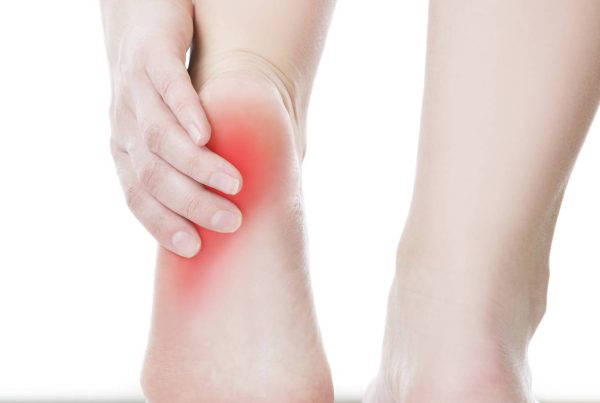The ankle, or the talocrural region,[1] is the region where the foot and the leg meet.[2] The ankle includes three joints: the ankle joint proper or talocrural joint, the subtalar joint, and the Inferior tibiofibular joint.[3][4][5] The movements produced at this joint are dorsiflexion and plantarflexion of the foot. In common usage, the term ankle refers exclusively to the ankle region. In medical terminology, “ankle” (without qualifiers) can refer broadly to the region or specifically to the talocrural joint.[1][6]
The main bones of the ankle region are the talus (in the foot), and the tibia and fibula (in the leg). The talocrural joint is a synovial hinge joint that connects the distal ends of the tibia and fibula in the lower limb with the proximal end of the talus.[7] The articulation between the tibia and the talus bears more weight than that between the smaller fibula and the talus.
Fractures
Symptoms of an ankle fracture can be similar to those of ankle sprains (pain), though typically they are often more severe by comparison. It is exceedingly rare for the ankle joint to dislocate in the presence of ligamentous injury alone.[citation needed]
The talus is most commonly fractured by two methods. The first is hyperdorsiflexion, where the neck of the talus is forced against the tibia and fractures. The second is jumping from a height – the body is fractured as the talus transmits the force from the foot to the lower limb bones.[15]
In the setting of an ankle fracture the talus can become unstable and subluxate or dislocate. People may complain of ecchymosis (bruising), or there may be an abnormal position, abnormal motion, or lack of motion. Diagnosis is typically by X-ray. Treatment is either via surgery or casting depending on the fracture types.[citation needed]
Signs and symptoms
Knowing the symptoms that can be experienced with a sprain is important in determining that the injury is not really a break in the bone. When a sprain occurs, blood vessels will leak fluid into the tissue that surrounds the joint. White blood cells responsible for inflammation migrate to the area, and blood flow increases as well.[1] Along with this inflammation, swelling from the fluid and pain is experienced. The nerves in the area become more sensitive when the injury is suffered, so pain is felt as throbbing and will worsen if there is pressure placed on the area. Warmth and redness are also seen as blood flow is increased. Also present is a decreased ability to move the joint, and difficulty using the affected leg.
Cause
Movements – especially twisting, turning, and rolling of the foot – are the primary cause of an ankle sprain.[2]
The risk of a sprain is greatest during activities that involve explosive side-to-side motion, such as squash, tennis or basketball. Sprained ankles can also occur during normal daily activities such as stepping off a curb or slipping on ice. Returning to activity before the ligaments have fully healed may cause them to heal in a stretched position, resulting in less stability at the ankle joint. This can lead to a condition known as Chronic Ankle Instability (CAI), and an increased risk of ankle sprains.
The following factors can contribute to an increased risk of ankle sprains:
- Weak muscles/tendons that cross the ankle joint, especially the muscles of the lower leg that cross the outside, or lateral aspect of the ankle joint (i.e. peroneal or fibular muscles);
- Weak or lax ligaments that join together the bones of the ankle joint – this can be hereditary or due to overstretching of ligaments as a result of repetitive ankle sprains;
- Inadequate joint proprioception (i.e. sense of joint position);
- Slow neuron muscular response to an off-balance position;
- Running on uneven surfaces;
- Shoes with inadequate heel support[citation needed]; and
- Wearing high-heeled shoes – due to the weak position of the ankle joint with an elevated heel, and a small base of support.
Ankle sprains occur usually through excessive stress on the ligaments of the ankle. This can be caused by excessive external rotation, inversion or eversion of the foot caused by an external force. When the foot is moved past its range of motion, the excess stress puts a strain on the ligaments. If the strain is great enough to the ligaments past the yield point, then the ligament becomes damaged, or sprained.[3][4]
Classification
Ankle sprains are classified grade 1, 2, and 3.[5] Depending on the amount of damage or the number of ligaments that are damaged, each sprain is classified from mild to severe. A grade 1 sprain is defined as mild damage to a ligament or ligaments without instability of the affected joint. A grade 2 sprain is considered a partial tear to the ligament, in which it is stretched to the point that it becomes loose. A grade 3 sprain is a complete tear of a ligament, causing instability in the affected joint.[6] Bruising may occur around the ankle.[7]
Inversion (lateral) ankle sprain
The most common type of ankle sprain occurs when the foot is inverted too much, affecting the lateral side of the foot. When this type of ankle sprain happens, the outer, or lateral, ligaments are stretched too much. The anterior talofibular ligament is one of the most commonly involved ligaments in this type of sprain. Approximately 70-85% of ankle sprains are inversion injuries.
When the ankle becomes inverted, the anterior talofibular and calcaneofibular ligaments are damaged. This is the most common ankle sprain.
Eversion (medial) ankle sprain
A less common type of ankle sprain is called an eversion injury, affecting the medial side of the foot. This happens when the foot, instead of the ankle rotating medially resulting in an inversion (the foot being rolling to the inside), the ankle rotates laterally resulting in an eversion (when the foot rolls to the outside). When this occurs, the medial, or deltoid, ligament is stretched too much.
High ankle sprain
A high ankle sprain is an injury to the large ligaments above the ankle that join together the two long bones of the lower leg, called the tibia and fibula. High ankle sprains commonly occur from a sudden and forceful outward twisting of the foot, which commonly occurs in contact and cutting sports such as football, rugby, ice hockey, roller derby, basketball, volleyball, lacrosse, softball, baseball, track, ultimate frisbee, gridiron, tennis and badminton and horse riding.
Diagnosis
The diagnosis of a sprain relies on the medical history, including symptoms, as well as making a differential diagnosis, mainly in distinguishing it from strains or bone fractures. The Ottawa ankle rule is a simple, widely used rule to help differentiate fractures of the ankle or mid-foot from other ankle injuries that do not require x-ray radiography. It has a specificity of nearly 100%, meaning that a patient who tests negative, according to the rule almost certainly does not have an ankle fracture.[8]
Treatment
Initial treatment commonly consists of rest, icing, compression and elevation (which is often referred to by the mnemonic RICE or sometimes PRICE with P being “protection”). These are recommended by physicians for the treatment of soft tissue damage, and sprained ankles are one of the most common soft tissue injuries. RICE helps limit the amount of swelling to the area, and “facilitates venous and lymphatic drainage”.[9]
Conservative measures
Ice is often used to reduce swelling in cycles of 15–20 minutes on and 20–30 minutes off. Icing an ankle too long can cause cold injuries, indicated if the area turns white.[10]
In uncomplicated lateral ankle sprains, swelling of the soft tissue can be prevented with compression around both malleoli, elevation of the injured ankle higher than the heart, and pain-free exercises.[11]
An orthopedic walking boot is often used for the treatment of a sprained ankle injury. Braces and crutches are also used to help alleviate the pain so the injured ankle can heal as quickly and painlessly as possible.
Although found to be less effective than casts, compression bandages are used to provide support and compression for sprained ankles. Wrapping is started at the ball of the foot and slowly continued up to the base of the calf muscle, which pushes the swelling up toward the center of the body so that it does not gather in the foot.
Rehabilitation
Many different types of rehabilitation exercises can be done to aid an ankle sprain regardless of the severity of the injury. The purpose of rehabilitation gives the ability for the ankle to regain strength and flexibility. A sprained ankle becomes swollen due to the increased amount of edema within the tissue, since this physiological effect is the foundation of the pain the decline of edema is the main goal during the beginning of rehabilitation.[12] This can be done instantly by implementing the RICE mechanism which is resting the ankle, applying ice, compressing, and elevating it.[9] The emphasis of the first week of rehabilitation should be on protecting the ankle to avoid further damage. As the healing progresses, stress can be applied by different mechanisms until the ankle is fully recovered.[13] The key to a fast recovery is to implement all the different types of ankle sprain exercises so that the range of motion will increase while the pain is decreasing.[14]
In cases where the ankle does not heal in an appropriate amount of time, other exercises need to be implemented so that strength and flexibility can be regained. Physical therapists assign different types of ankle sprain exercises that deal with ankle flexibility, strengthening, balance, and agility. If an ankle sprain does not heal properly, the joint may become unstable and may lead to chronic pain.[15] Receiving proper treatment and performing exercises that promote ankle function is important to strengthen the ankle and prevent further injury.
Ankle immobilization
A short period of immobilization in a below-knee cast or in an Aircast leads to a faster recovery at 3 months compared to a tubular compression bandage.[16] In contrast, a randomized controlled trial has concluded that appropriate exercise immediately after a sprain improves function and recovery.[17] These exercises were focused on increasing ankle range of movement, activation and strengthening of ankle musculature, and restoring normal sensorimotor control, and were carried out for 20 minutes, three times a day.[17] After the injury it is advisable to not to walk for a couple of days. Bed rest will help to accelerate the healing process and eliminate the chance of mishandling the affected limb. Driving vehicles or operating machinery should not be attempted.
The amount of therapy that a person can handle will depend on their level of pain and the grade of sprain they experienced. It is not recommended to return to sports or extreme physical activities until hopping on the ankle is possible without pain. Wearing high-top tennis shoes may also help prevent ankle sprains if the shoes used are laced snugly and if the ankle is taped with a wide, nonelastic adhesive tape.[18]
Ankle mobilization/manipulation
For acute ankle sprains, manual joint mobilization/manipulation of the ankle has been found to diminish pain and increase range of motion. For treatment of subacute/chronic lateral ankle sprains, these techniques improved ankle range-of-motion, decreased pain and improved function.[19]
Ankle exercises
To prevent sprains or re-injury from occurring, strengthening and stretching exercises should be done through a full range of ankle motion. To improve ankle mobility, ankle circles can be performed by extending the legs in front of the body and then moving the foot up and down, side to side, or rotating the foot in a circle. Another common exercise to improve mobility as well as proprioception is to use the toes to draw the letters of the alphabet in the air. Most importantly, the lateral aspect of the ankle joint should be strengthened with eversion exercises (i.e. underside of the foot is turned outward against resistance) to improve lateral ankle stability.[20] Stretching is also an important component of a strengthening program, to help maintain joint flexibility.
Balance and stability training are especially important to retrain the ankle muscles to work together to support the joint.[21] This includes exercises that are performed by standing on one foot and using the injured ankle to lift the body onto its toes. To further enhance balance and stability, exercise devices such as the wobble board can be used, progressing from double-leg to single-leg stance, first with eyes open and then with eyes closed, for enhanced effectiveness.
Flexibility exercises
Example of a flexibility exercise is a towel stretch [22] and writing the alphabet with toes which will increase the range of motion.
Strengthening exercises
Ankle strengthening exercises are step ups and walking on toes which will strengthen the muscles around the swollen area.
Balance exercises
Balance exercises include the use of a wobble board, which helps the whole body function to maintain balance. The use of wobble boards has been shown to produce significantly positive results in gaining proper balance.[23]
Agility exercises
Plyometrics exercises such as squat jumps and power skipping should not be implemented until the ankle has regained full agility.
Other strategies that can be used to prevent ankle injury include:
- Ensure proper warm-up prior to stretching and activity;
- When running, choose level surfaces and avoid rocks or holes;
- Ensure that shoes have adequate heel support; and…
- If high-heeled shoes are worn, ensure that heels are no more than 2 inches in height, and avoid heels with a narrow base.
Prognosis
Most people improve significantly in the first two weeks. However, some still have problems with pain and instability after one year (5–30%). Re-injury is also very common.[24][25]
Epidemiology
Ankle sprains can occur through either sports or activities of daily living, and individuals can be at higher or lower risk depending on a variety of circumstances including their homeland, race, age, sex, or profession [26] In addition, there are different types of ankle sprains such as eversion ankle sprains and inversion ankle sprains. Overall, the most common type of ankle sprain to occur is an inversion ankle sprain, where excessive plantar flexion and supination cause the anterior talofibular ligament to be affected. A study showed that for a population of Scandinavians, inversion ankle sprains accounted for 85% of all ankle sprains [23] Most ankle sprains occur in more active people, such as athletes and regular exercisers.
Age
In a study comparing the prevalence of ankle sprains between age, race, and sex, individuals who were aged 10–19 years old had highest incidences of ankle sprains.[27] It can be suggested that adolescents are more physically active, which leads to higher chances of ankle sprains. Since sports deal with high utilization of the ankle, over 50% of ankle sprains are due to sport related injuries [28]
US Military
Moreover, average ankle sprains for the general U.S. population are estimated at 5-7 ankle sprains for every 1000 person-years; however a study showed that for military cadets’ incidences for ankle sprains were about 10 times those of the general population [29]
Male vs. female
Another study comparing gender influences on ankle sprains found that male and female counterparts had similar incidence rates of ankle sprains. However, at a specific age range of 19–25 years old, males were found to have a substantially greater rate of ankle sprains than females. Furthermore, at ages 30 and over, females showed a higher incidence of ankle sprains than males.[26] From this, it can be said that age and activity levels are better indicators of ankle sprain risks than gender.



